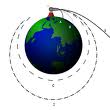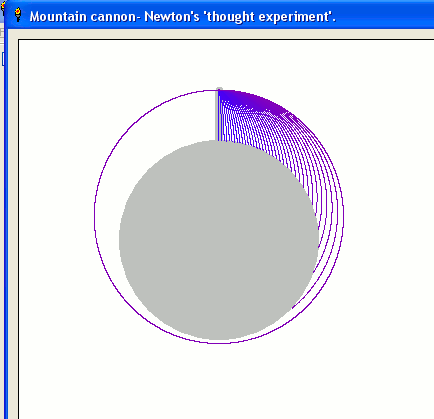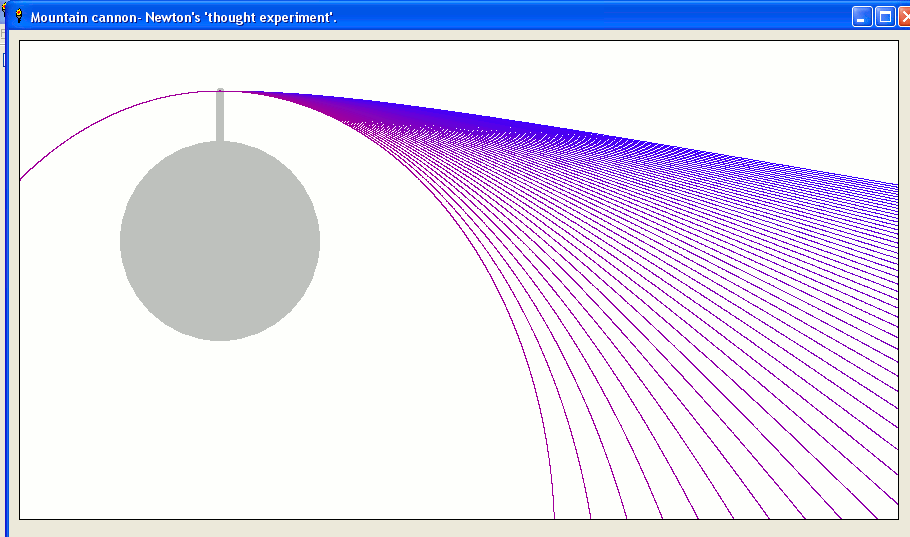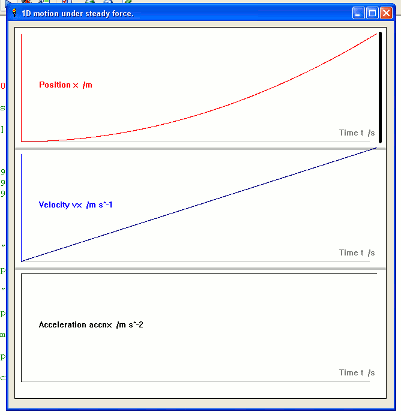
y = 0 ' initial displacement
vy = 0 ' initial velocity
t = 0 ' initial time
dt = 0.001 ' time interval between updates
[start]
accn =F /m ' Newton's Second Law
vy =vy +accn *dt ' since accn =vel'y change /time interval
y =y +vy *dt ' since velocity =pos'n change /time interval
t =t +dt ' ie time moves on a step of dt
if still in range, goto [start] and repeat.
This is a loop which we go round, stepping forward by a step dt in time which is small enough to create only small changes in the other variables. The results can be a table; exported as csv; or, best, displayed as a graph. This is quite the easiest way to see what is happening.

 Click 'refresh' to watch it again!
Click 'refresh' to watch it again!
'Initial conditions
x = 0 ' initial horizontal position. Try changing to say 10.
vx = 0 ' try changing this to say 5 m s^-1.
t = 0 ' initial time.
dt = 1 ' time interval between updates. ( Use .001 to slow it down.)
force = 1 ' constant, forward force. Try changing this to 0.
mass = 1 ' mass of moving object.
[here]
print t, x, vx, accnx
'The calculation loop
accnx =force /mass
vx =vx +accnx *dt
x =x +vx *dt
t =t +dt
scan
if x <500 then goto [here]
wait
end
'Initial conditions
x = 60 ' initial horizontal position.
t = 0 ' initial time.
dt = 1 ' time interval between updates.
mass = 1 ' mass of moving object.
[here] 'The calculation loop
print t, x, vx, accnx
if t >15 then force =2 else force =0
if t >30 then force =-4
accnx =force /mass
vx =vx +accnx *dt
x =x +vx *dt
t =t +dt
scan
if x <500 and x >0 then goto [here]
wait
end
This just printed a table of time, position, velocity and acceleration. It is much more useful to graph the results.

nomainwin
WindowWidth =650
WindowHeight =680
graphicbox #w.g, 10, 10, 620, 620
open "1D motion under steady force."for window as #w
#w, "trapclose [quit]"
#w.g, "fill white"
#w.g, "color lightgray ; backcolor lightgray"
#w.g, "up ; goto 590 190 ; down ; goto 10 190"
#w.g, "up ; goto 590 390 ; down ; goto 10 390"
#w.g, "up ; goto 590 590 ; down ; goto 10 590"
#w.g, "up ; goto 0 200 ; down ; boxfilled 620 204"
#w.g, "up ; goto 0 400 ; down ; boxfilled 620 404"
#w.g, "backcolor white"
#w.g, "color red ; up ; goto 10 190 ; down ; goto 10 10"
#w.g, "place 40 100"
#w.g, "\Position x /m"
#w.g, "color blue ; up ; goto 10 390 ; down ; goto 10 210"
#w.g, "place 40 300"
#w.g, "\Velocity vx /m s^-1"
#w.g, "color black ; up ; goto 10 590 ; down ; goto 10 410"
#w.g, "place 40 500"
#w.g, "\Acceleration accnx /m s^-2"
#w.g, "color darkgray"
#w.g, "place 540 580"
#w.g, "\Time t /s"
#w.g, "place 540 380"
#w.g, "\Time t /s"
#w.g, "place 540 180"
#w.g, "\Time t /s"
'Initial conditions
x = 0 ' initial horizontal position.
t = 0 ' initial time.
dt = 0.01 ' time interval between updates.
force = 1 ' constant, forward force.
mass = 1 ' mass of moving object.
[here] 'The calculation loop
print t, x, vx, accnx ' known max's 32, 500, 30, 1 from printing tomainwin
call display t, x, vx, accnx
accnx =force /mass
vx =vx +accnx *dt
x =x +vx *dt
t =t +dt
scan
if x <500 then goto [here]
wait
sub display t, x, vx, accnx
#w.g, "size 5 ; set 608 "; 190 -180 *x /500; " ; size 1"
displayHoriz =10 +600 *t /32
yx =190 -180 *x /500
yvx =390 -180 *vx /30
yaccnx =590 -180 *accnx /1
#w.g, "color red ; set "; displayHoriz; " "; yx
#w.g, "color darkblue ; set "; displayHoriz; " "; yvx
#w.g, "color black ; set "; displayHoriz; " "; yaccnx
end sub
[quit]
close #w
end
Similarly, with the varying force,
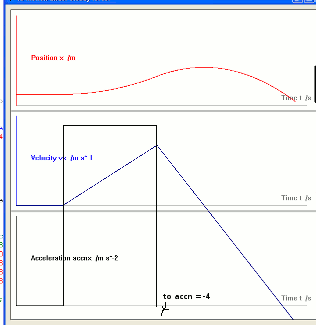
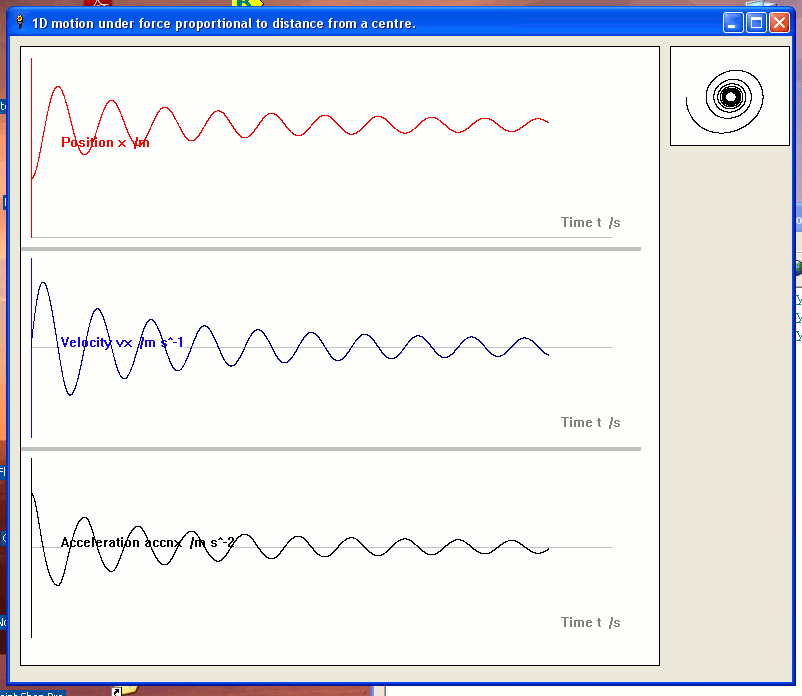
nomainwin
WindowWidth =790
WindowHeight =680
UpperLeftX = 20
UpperLeftY = 20
graphicbox #w.g, 10, 10, 640, 620
graphicbox#w.g2, 660, 10, 120, 100
open "1D motion under force proportional to distance from a centre." for window as #w
#w, "trapclose [quit]"
#w.g2, "down"
#w.g, "fill white"
#w.g, "color lightgray ; backcolor lightgray"
#w.g, "up ; goto 590 190 ; down ; goto 10 190"
#w.g, "up ; goto 590 300 ; down ; goto 10 300"
#w.g, "up ; goto 590 500 ; down ; goto 10 500"
#w.g, "up ; goto 0 200 ; down ; boxfilled 620 204"
#w.g, "up ; goto 0 400 ; down ; boxfilled 620 404"
#w.g, "backcolor white"
#w.g, "color red ; up ; goto 10 190 ; down ; goto 10 10"
#w.g, "place 40 100"
#w.g, "\Position x /m"
#w.g, "color blue ; up ; goto 10 390 ; down ; goto 10 210"
#w.g, "place 40 300"
#w.g, "\Velocity vx /m s^-1"
#w.g, "color black ; up ; goto 10 590 ; down ; goto 10 410"
#w.g, "place 40 500"
#w.g, "\Acceleration accnx /m s^-2"
#w.g, "color darkgray"
#w.g, "place 540 580"
#w.g, "\Time t /s"
#w.g, "place 540 380"
#w.g, "\Time t /s"
#w.g, "place 540 180"
#w.g, "\Time t /s"
'Initial conditions
x = 10 ' initial horizontal position.
t = 0 ' initial time.
dt = 0.01 ' time interval between updates.
mass = 1 ' mass of moving object.
[here] 'The calculation loop
print t, x, vx, accnx '
call display t, x, vx, accnx
' Define a force towards 40 mark and proportional to distance from it.
force =( 40 -x) /2
' Add air drag prop'l v^2.
if vx >0 then force =force -( vx^2 /100) else force =force +( vx^2 /100)
accnx =force /mass
vx =vx +accnx *dt
x =x +vx *dt
t =t +dt
scan
if x <500 then goto [here]
wait
sub display t, x, vx, accnx
' #w.g, "size 5 ; set 608 "; 150 -180 *x /100; " ; size 1"
#w.g2, "set "; x *1.5; " "; vx *2 +50
displayHoriz =10 +600 *t /100
yx =150 -180 *x /100
yvx =300 -180 *vx /50
yaccnx =500 -180 *accnx /50
#w.g, "color red ; set "; displayHoriz; " "; yx
#w.g, "color darkblue ; set "; displayHoriz; " "; yvx
#w.g, "color black ; set "; displayHoriz; " "; yaccnx
end sub
[quit]
close #w
end
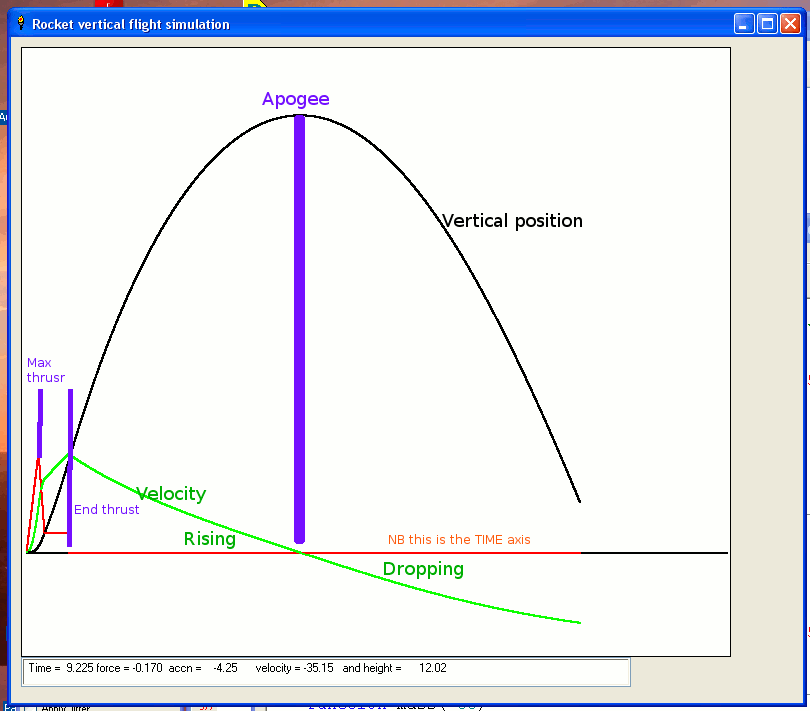
nomainwin
UpperLeftX = 10
UpperLeftY = 10
WindowWidth = 800
WindowHeight = 700
graphicbox #w.g, 10, 10, 710, 610
textbox #w.t, 10, 620, 610, 30
open "Rocket vertical flight simulation" for window as #w
#w, "trapclose [quit]"
#w.g, "size 2 ; goto 5 505 ; down ; goto 705 505"
mbody = 0.0200 ' fixed mass of body
mfuel = 0.0100 ' 10gm of fuel
mcase = 0.0200 ' 20gm casing & nozzle.
burntime = 0.7 ' burn lasts for this time
burnrate = mfuel /burntime ' assume linear reaction rate
A = 0.0004 ' csa of rocket
g = 9.81 ' acc'n of gravity
D = 1.2 ' density of air
Cd = 0.75 ' allows for the streamlined shape
y = 0 ' initial vertical height
vy = 0 ' initial vertical displacement
t = 0 ' initial time
dt = 0.001 ' time interval between updates
accn = 0
hasTakenOf = 0
global mbody, mfuel, mcase, burntime, burnrate, A, g, Cd, y, vy, t, dt, g, D
[here]
force =thrust( t) -g *mass( t) -drag( t)
if hasTakenOff <>0 then accn =force /mass( t) else accn =0
if thrust( t) >( mass( t) *g) then hasTakenOff =1
vy =vy +accn *dt
#w.g, "color green ; set "; 5 +600 *t /10; " "; 505 -500 *vy /250
y =y +vy *dt
t =t +dt
#w.t, " Time = "; using( "##.###", t); " force = "; using( "##.###", force);_
" accn = "; using( "#####.##", accn); " velocity = "; using( "###.##", vy);_
" and height = "; using("#######.##", y)
#w.g, "color black ; set "; 5 +600 *t /10; " "; 505 -500 *y /120
scan
if y <500 and y >-1 then goto [here]
wait
' _____________________________________________________________________
function thrust( tt)
th =0
if tt <=0.7 then th =2 else th =0
if tt <=0.3 then th =10 -80 *( tt -0.2)
if tt <=0.2 then th =50 *tt
#w.g, "color red ; set "; 5 +600 *t /10; " "; 505 -500 *th /50
thrust =th
end function
' _____________________________________________________________________
function mass( tt)
select case tt
case tt <=0.7 ' it burns 0.0035kg in 0.7s.
m =mbody +mcase +mfuel -tt *burnrate
case else
m =mbody +mcase
end select
mass =m
end function
'____________________________________________________________________________
function drag( tt)
if vy >0 then drag =0.5 *D *vy^2 *Cd *A else drag =-0.5 *D *vy^2 *Cd *A
end function
[quit]
close #w
end
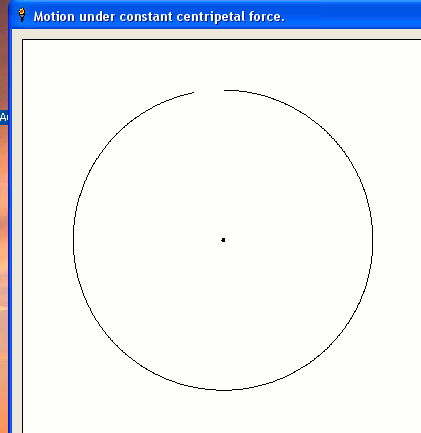
' /////////////////// CentralForceConstant
' to-dos:
' Makeforce vector display length proportional to magnitude
' Offer option to display all at say 1/10 scale
' add sound freq'y proportional to velocity?
nomainwin
UpperLeftX = 10
UpperLeftY = 2
WindowWidth = 920
WindowHeight = 650
graphicbox #w.g1, 10, 10, 880, 480
graphicbox #w.g3, 500, 510, 100, 100
open "Motion under constant centripetal force." for window as #w
#w, "trapclose [quit]"
global pi
pi =3.1415923535
#w.g1, "down ; size 4 ; set 200 200 ; size 1; flush"
#w.g3, "down ; backcolor red ; color red"
vmax =10
x = 0 ' initial horizontal position
vx =vmax
y = 15 ' initial vertical height
vy = 0 ' initial vertical velocity
force =( vx^2 +vy^2) /15 ' exact circular orbit velocity. Try *0.9 or *1.2
t = 0 ' initial time
dt = 0.01 ' time interval between updates
[here]
RadDist =( x^2 +y^2)^0.5
theta =atan2( y, x)
print x, y, theta
accny =-1 *force *sin( theta)
accnx =-1 *force *cos( theta)
vy =vy +accny *dt
y =y +vy *dt
vx =vx +accnx *dt
x =x +vx *dt
t =t +dt
#w.g1, "set "; 200 +10 *x; " "; 200 -10 *y
#w.g3, "cls ; home ; north ; turn "; 90 -theta *180 /pi; " ; circle 30 ; size 2 ; go -30"
scan
if RadDist >10 and RadDist <80 then goto [here]
#w.g1, "flush"
wait
function atan2( y, x)
if x >0 then at =atn( y /x)
if y >=0 and x <0 then at =atn( y /x) +pi
if y <0 and x <0 then at =atn( y /x) -pi
if y >0 and x =0 then at = pi /2
if y <0 and x =0 then at = 0 -pi /2
if y =0 and x =0 then notice "undefined": end
atan2 =at
end function
[quit]
close #w
end
If the force is NOT constant, but proportional to distance (think swinging a cat round your head on its elastic tail!) we get interesting shapes:-
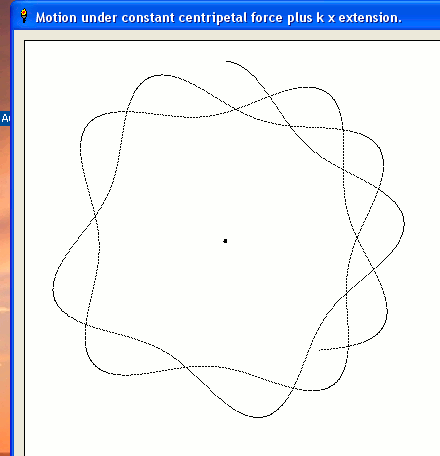
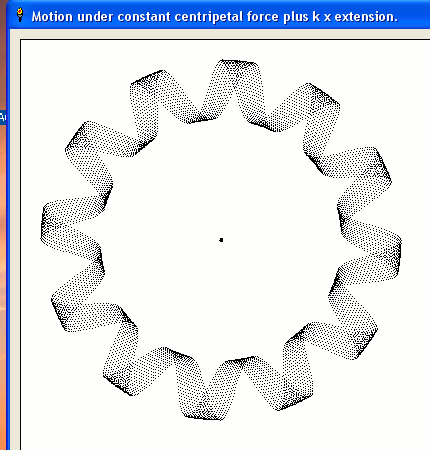
' /////////////////// CentralForceKTimesExtn
nomainwin
UpperLeftX = 10
UpperLeftY = 2
WindowWidth = 920
WindowHeight = 650
graphicbox #w.g1, 10, 10, 880, 480
graphicbox #w.g3, 500, 510, 100, 100
open "Motion under constant centripetal force plus k x extension." for window as #w
#w, "trapclose [quit]"
global pi
pi =3.1415923535
k =10 ' Hooke's Law, spring constant
#w.g1, "down ; size 4 ; set 200 200 ; size 1; flush"
#w.g3, "down ; backcolor red ; color red"
vmax =10
x = 0 ' initial horizontal position
vx =vmax
y = 18 ' initial vertical height
vy = 0 ' initial vertical velocity
force1 =( vx^2 +vy^2) /15 ' exact circular orbit velocity. Try *0.9 or *1.2
t = 0 ' initial time
dt = 0.01 ' time interval between updates
[here]
RadDist =( x^2 +y^2)^0.5
theta =atan2( y, x)
print x, y, theta
force =force1 + ( RadDist -15) *k
accny =-1 *force *sin( theta)
accnx =-1 *force *cos( theta)
vy =vy +accny *dt
y =y +vy *dt
vx =vx +accnx *dt
x =x +vx *dt
t =t +dt
#w.g1, "set "; 200 +10 *x; " "; 200 -10 *y
#w.g3, "cls ; home ; north ; turn "; 90 -theta *180 /pi; " ; circle 30 ; size 2 ; go -30"
scan
if RadDist >10 and RadDist <80 then goto [here]
#w.g1, "flush"
wait
function atan2( y, x)
if x >0 then at =atn( y /x)
if y >=0 and x <0 then at =atn( y /x) +pi
if y <0 and x <0 then at =atn( y /x) -pi
if y >0 and x =0 then at = pi /2
if y <0 and x =0 then at = 0 -pi /2
if y =0 and x =0 then notice "undefined": end
atan2 =at
end function
[quit]
close #w
end
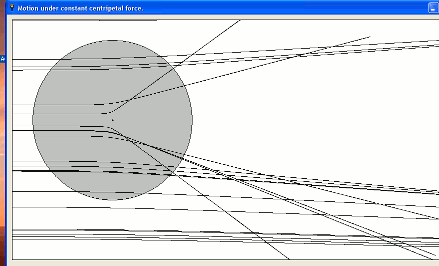
' /////////////////// CentralForceRepulsive
nomainwin
UpperLeftX = 10
UpperLeftY = 2
WindowWidth = 920
WindowHeight = 650
graphicbox #w.g1, 10, 10, 880, 480
graphicbox #w.g3, 500, 510, 100, 100
open "Motion under constant centripetal force." for window as #w
#w, "trapclose [quit]"
global pi
pi =3.1415923535
#w.g1, "goto 200 200 ; down ; backcolor lightgray ; circlefilled 160 ; size 3 ; set 200 200 ; size 1 ; flush"
#w.g3, "down ; backcolor red ; color red"
c = 0
'for yy =-27 to 27 step 0.3
for i =1 to 1000
x = -20 ' initial horizontal position
y = -27 +55 *rnd( 1) ' random incident height
vx = 50
vy = 0 ' initial vertical velocity
t = 0 ' initial time
dt = 0.001 ' time interval between updates
[here]
theta =atan2( y, x)
force =(( x^2 +y^2)^-1) *1000
accny =1 *force *sin( theta)
accnx =1 *force *cos( theta)
vy =vy +accny *dt
y =y +vy *dt
vx =vx +accnx *dt
x =x +vx *dt
t =t +dt
'#w.g1, "color "; c; " 40 "; 255 -c
#w.g1, "set "; 200 +10 *x; " "; 200 -10 *y
#w.g3, "cls ; home ; north ; turn "; 90 -theta *180 /pi; " ; circle 30 ; size 2 ; go -30"
scan
if ( x^2 +y^2) <4900 then goto [here]
'c =c +1
next i'next yy
#w.g1, "flush"
wait
function atan2( y, x)
if x >0 then at =atn( y /x)
if y >=0 and x <0 then at =atn( y /x) +pi
if y <0 and x <0 then at =atn( y /x) -pi
if y >0 and x =0 then at = pi /2
if y <0 and x =0 then at = 0 -pi /2
if y =0 and x =0 then notice "undefined": end
atan2 =at
end function
[quit]
close #w
end

